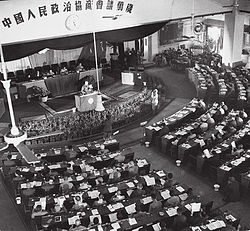Chinese People's Political Consultative Conference
The Chinese People's Political Consultative Conference (CPPCC, Chinese: 中国人民政治协商会议), also known as the People's PCC (Chinese: 人民政协, ![]() listen (info • help)) or simply the PCC (Chinese: 政协), is a political organization in the People's Republic of China. The organisation is made up of delegates from eight legally-allowed political parties and other organisations, as well as independent members.
listen (info • help)) or simply the PCC (Chinese: 政协), is a political organization in the People's Republic of China. The organisation is made up of delegates from eight legally-allowed political parties and other organisations, as well as independent members.
The CPPCC is controlled by the United Front Work Department.[2][3]
Chinese People's Political Consultative Conference Media
References
- ↑ "测试页面". Archived from the original on 2018-01-13. Retrieved 2018-01-13.
- ↑ Joske, Alex (June 9, 2020). "The party speaks for you: Foreign interference and the Chinese Communist Party's united front system". Australian Strategic Policy Institute. Archived from the original on June 9, 2020. Retrieved 2020-06-10.
- ↑ "The United Front in Communist China" (PDF). Central Intelligence Agency. May 1957. Archived (PDF) from the original on January 23, 2017. Retrieved June 10, 2020.


